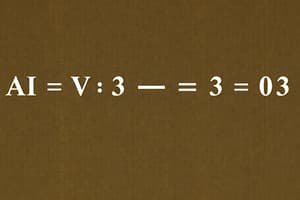Podcast
Questions and Answers
What does the accounting equation capital represent?
What does the accounting equation capital represent?
- Total cash available in the business
- Total assets owned by the business
- Total liabilities owed by the business
- The residual interest in the assets after liabilities are deducted (correct)
How can the accounting equation be rearranged?
How can the accounting equation be rearranged?
- Liabilities = Assets + Capital
- Assets = Capital - Liabilities
- Liabilities = Capital - Assets
- Assets = Capital + Liabilities (correct)
What is the effect of drawings on capital?
What is the effect of drawings on capital?
- Drawings can increase or decrease capital
- Drawings reduce capital (correct)
- Drawings increase capital
- Drawings do not affect capital
What is included in the term capital for a business?
What is included in the term capital for a business?
What does the format of the accounting equation reveal about financial position?
What does the format of the accounting equation reveal about financial position?
If a business has $5,000 in assets and $2,000 in liabilities, what is the capital?
If a business has $5,000 in assets and $2,000 in liabilities, what is the capital?
How does the accounting equation ensure the balance of debits and credits?
How does the accounting equation ensure the balance of debits and credits?
What happens to capital if a business incurs a loss?
What happens to capital if a business incurs a loss?
What is the impact on the accounting equation when Anushka starts the business with $5,000 of cash?
What is the impact on the accounting equation when Anushka starts the business with $5,000 of cash?
How does the loan of $10,000 from the bank affect the accounting equation?
How does the loan of $10,000 from the bank affect the accounting equation?
What happens to the accounting equation when Anushka purchases a van for $12,000 cash?
What happens to the accounting equation when Anushka purchases a van for $12,000 cash?
If Anushka purchases inventory on credit for $2,500, how does it impact her accounting equation?
If Anushka purchases inventory on credit for $2,500, how does it impact her accounting equation?
What is the result of selling inventory for a total of $400 when the cost of the sold inventory is $250?
What is the result of selling inventory for a total of $400 when the cost of the sold inventory is $250?
When Anushka pays $60 in interest, which part of the accounting equation is impacted?
When Anushka pays $60 in interest, which part of the accounting equation is impacted?
What occurs when Anushka repays $250 of the loan?
What occurs when Anushka repays $250 of the loan?
How does the withdrawal of $10 for personal expenses influence Anushka's accounting equation?
How does the withdrawal of $10 for personal expenses influence Anushka's accounting equation?
What does the overall transaction involving the purchasing of inventory and the sale of part of it reveal about the accounting equation?
What does the overall transaction involving the purchasing of inventory and the sale of part of it reveal about the accounting equation?
Flashcards are hidden until you start studying
Study Notes
Accounting Equation
- The accounting equation demonstrates the relationship between assets, liabilities and capital (or equity) within a business.
- It can be represented as: Assets = Capital + Liabilities
- The accounting equation demonstrates how assets are funded, either through owner investment (Capital) or by amounts owed to creditors (Liabilities).
Capital
- Represents the owner's investment in the business, including retained profits or losses.
- In a sole proprietorship, capital belongs to the owner.
- In a limited liability company (LLC), capital is referred to as "Equity."
Drawings
- Drawings are amounts taken out of the business by the owner, leading to a reduction in capital.
Income & Expenses
- Income and expenses relate to a businesses financial performance and ultimately result in a profit or loss for the period.
- Income increases capital, while expenses decrease capital.
Expanding the Accounting Equation
- The equation can be expanded to include the impact of drawings and profit (income less expenses):
- Assets = Capital introduced + (Income – Expenses) – Drawings + Liabilities
Dual Aspect of Accounting
- Every transaction has a dual aspect, affecting at least two components of the accounting equation.
- This ensures that the equation always balances, even if multiple elements are impacted.
Example of Accounting Equation
- Anushka starts a business:
- Invests 5,000cash(Asset)andincreasescapitalby5,000 cash (Asset) and increases capital by 5,000cash(Asset)andincreasescapitalby5,000.
- Takes out a loan of 10,000(Liability),increasingcash(Asset)by10,000 (Liability), increasing cash (Asset) by 10,000(Liability),increasingcash(Asset)by10,000.
- Purchases a van for 12,000cash(Asset),decreasingcashby12,000 cash (Asset), decreasing cash by 12,000cash(Asset),decreasingcashby12,000 and increasing the van (Asset) by $12,000.
- Purchases inventory on credit for 2,500,increasinginventory(Asset)by2,500, increasing inventory (Asset) by 2,500,increasinginventory(Asset)by2,500 and creating a trade payable (Liability) of $2,500.
- Sells inventory for 400,increasingtradereceivable(Asset)by400, increasing trade receivable (Asset) by 400,increasingtradereceivable(Asset)by400, recording revenue (Income) of $400.
- Decreases inventory (Asset) by 250(costofgoodssold)andrecordscostofsales(Expense)of250 (cost of goods sold) and records cost of sales (Expense) of 250(costofgoodssold)andrecordscostofsales(Expense)of250.
- Result: The accounting equation remains balanced throughout each transaction as the dual aspect is applied.
Studying That Suits You
Use AI to generate personalized quizzes and flashcards to suit your learning preferences.




